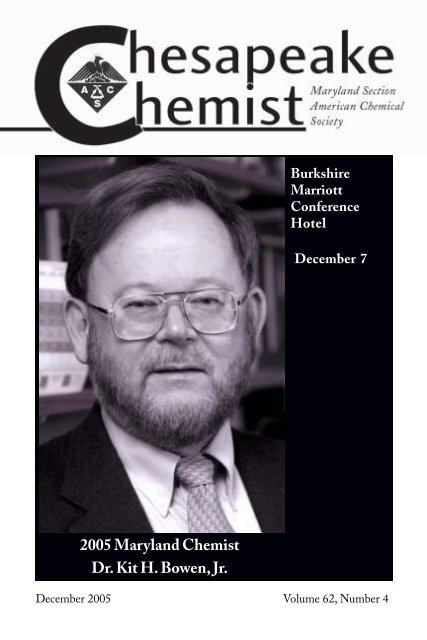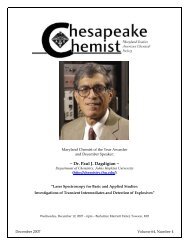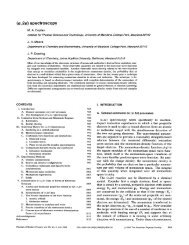2005 Maryland Chemist Dr. Kit H. Bowen, Jr. - JHU Department of ...
2005 Maryland Chemist Dr. Kit H. Bowen, Jr. - JHU Department of ...
2005 Maryland Chemist Dr. Kit H. Bowen, Jr. - JHU Department of ...
Create successful ePaper yourself
Turn your PDF publications into a flip-book with our unique Google optimized e-Paper software.
BurkshireMarriottConferenceHotelDecember 7<strong>2005</strong> <strong>Maryland</strong> <strong>Chemist</strong><strong>Dr</strong>. <strong>Kit</strong> H. <strong>Bowen</strong>, <strong>Jr</strong>.December <strong>2005</strong> Volume 62, Number 4
<strong>Maryland</strong> <strong>Chemist</strong> AwardThe <strong>Maryland</strong> <strong>Chemist</strong> Award was established in 1962 to recognize and tohonor, each year, a member <strong>of</strong> the <strong>Maryland</strong> Section for outstanding achievement inthe fields <strong>of</strong> chemistry. The achievement, as originally stated, may be in pure orapplied chemistry, chemical engineering, or chemical education. Some recipientshave distinguished themselves in management.The section’s Bylaw VIII (applicable section quoted below) establishes therules <strong>of</strong> selection <strong>of</strong> recipients <strong>of</strong> the <strong>Maryland</strong> <strong>Chemist</strong> Award. Recommendations<strong>of</strong> the Awards Committee must be approved by the section <strong>of</strong>ficers.“Recipients <strong>of</strong> the <strong>Maryland</strong> <strong>Chemist</strong> Award must have been members <strong>of</strong> the sectionfor a minimum <strong>of</strong> five years and have made outstanding contributions to chemistryas defined in the Constitution <strong>of</strong> the Society (chemistry is defined in broad terms).The work on which the award is based should have been performed in <strong>Maryland</strong>.”Previous Recipients <strong>of</strong> the Award1962 E. Emmet Reid1963 W. Mansfield Clark1964Alsoph H. Corwin1965 John C. Krantz, <strong>Jr</strong>.1966 Belle O. Talbot1967 Walter S. Koski1968 George L. Braude1969 Leslie Hellerman1970 Paul H. Emmett1971 Giles B. Cooke1972 Arnold M. Seligman1973 Lester P. Kuhn1974 Joyce J. Kaufman1975 Benjamin Witten1976 Richard L. Hall1977 Henry C. Freimuth1978 Gunther L. Eichhorn1979 Emil H. White1980 M. Gali Sanchez1981 Paul O. P. Ts’o1982 Joseph L. Katz1983 Shih-Yi Wang1984 Nicolas Zenker1985 John Lambooy1986 David F. Roswell1987 Gary H. Posner1988 Edward J. Poziomek1989 Catherine C. Fenselau1990 Alex Nickon1991 Cecil H. Robinson1992 Craig A. Townsend1993 Ernest F. Silversmith1994 Yale H. Caplan1995 Richard H. Smith, <strong>Jr</strong>.1996 Shekar Munavalli1997 WuCheng Cheng1998 Joel F. Liebman1999 Marc D. Donohue2000 Haleem J. Issaq2001 Raymond A. Mackay2002 R. S. Hosmane2003 Linda M. Sweeting2004 Michael F. SummersDecember Historical Events in <strong>Chemist</strong>ryby Leopold May, The Catholic University <strong>of</strong> America, Washington, D.C.December 6, 1920 George Porter studied free radicals produced in gaseousphotochemical reactions using the flash-photolysis methodthat he developed. He shared the Nobel Prize in 1967with Manfred Eigen and Ronald G. W. Norrish for theirstudies <strong>of</strong> extremely fast chemical reactions, effected bydisturbing the equilibrium by means <strong>of</strong> very short pulses<strong>of</strong> energy. He was born on this date.December 8, 1878 Eugene C. Bingham, who was born on this date, was aresearcher on plastic flow and viscosity.Continued on page 72
ACS <strong>Maryland</strong> Section - Officers and Committee ChairsSection OfficersChair: Alan C. Samuels, 410-436-5874alan.samuels@sbccom.apgea.army.milVice-chair: Sandra K. Young410-306-0679skyoung@arl.army.milChair-elect: Stephanie J. Watson301-975-6448stephanie.watson@nist.govSecretary: Lev Ryzhkov, 410-704-3831lryzhkov@towson.eduTreasurer: Angela Sherman, 410-532-5713CND <strong>of</strong> MD4701 North Charles StreetBaltimore, MD 21210asherman@ndm.eduCouncilorsMerle I. Eiss Donald Jones410-484-0521 202-364-2740meiss32@aol.com djones@erols.comDavid Roswell Charles Rowell410-617-2458 410-647-9452droswell@loyola.edu rowell@toad.netAlternate CouncilorsShekar Munavalli, Shirish Shah, Joseph ToppingMembers at LargeMaurice Iwunze, Jan Kolakowski, Liina LadonDemetrium Michos, Sara Narayan, James NwabaCommittee ChairsStudent Awards (March):George Farrant, 410-455-4120gfarrant@ccbcmd.eduRemsen Award (May/June): Lev RyzhkovBraude Award (October): Charles Rowell<strong>Maryland</strong> <strong>Chemist</strong> Award (December):Shekhar Munavalli, 410-436-2819Shekar.munavalli@sbccom.apgea.army.mil<strong>Maryland</strong> Service Award:Shree Iyengar, 410-541-2266<strong>Maryland</strong> Section on the Web: http://mdchem.orgWebmaster: Sandy Young(chemists4fun@yahoo.com)Paul Smith, pjsmith@umbc.eduProgramsArchives: Ernie Silversmith, 443-885-3214Career Planning: Linh Cheong, 410-762-1159Earth Day: Paul Smith & Sandy YoungEnvironmental Issues:Shirish Shah, 410-704-2720sshah@towson.eduSandy YoungFinance Committee:Jan Kolakowski,410-436-2755, jan.kolakowski@us.army.milGovernment Relations:Shirish Shah & Robert von TerschLong Range Planning: Shekar MunavalliMARM: Shirish Shah & Alan SamuelsMembership: Merle EissMinority Affairs:Alfred Amah, 410-602-7164,f-amah@mail.vjc.eduPublic Relations:Shirish Shah & Walter Roy,Walter_Roy@mccormick.comRetired <strong>Chemist</strong>s: Alvin Bober, 410-581-5321Women <strong>Chemist</strong>s/Younger <strong>Chemist</strong>s:Sara Narayan, 410-602-7326Amanda MillerEductional Programs:<strong>Chemist</strong>ry Olympiad/Chem-a-Thon:Shirish Shah & Mike Zapf,Mike_Zapf@mccormick.comContinuing Education/High School Education:Shirish ShahEllen PisciottaKids & <strong>Chemist</strong>ry/<strong>Chemist</strong>ry-in-the-Library:Sue Procell, 410-436-4604,suzanne.procell@us.army.milSandy YoungNational <strong>Chemist</strong>ry Week (NCW):Shirish Shah & Sandy YoungChesapeake <strong>Chemist</strong> Editor: cakvt@hotmail.comCindy Kronman734 Benfield RoadSeverna Park, MD 21146The Chesapeake <strong>Chemist</strong> is published monthly September through May by the <strong>Maryland</strong> Section <strong>of</strong>the American Chemical Society. Send submissions to the editor in electronic format. The <strong>Maryland</strong>Section is not responsible for opinions expressed herein. Editorials express the opinions only <strong>of</strong> theauthors. The editor is not responsible for all unsigned material.3
4December Dinner MeetingWednesday, December 7, <strong>2005</strong>Burkshire Marriott Conference Hotel, Towson, <strong>Maryland</strong>6:00 - 6:45 pm Registration and Social6:45 - 7:45 pm Dinner7:45 - 8:00 pm <strong>Maryland</strong> <strong>Chemist</strong> Award Presentation8:00 - 9:00 pm <strong>Dr</strong>. <strong>Kit</strong> H. <strong>Bowen</strong>, <strong>Jr</strong>.Johns Hopkins UniversityCost for the dinner is $25.00 for members; $20.00 for spouses, retired chemistsand guests, and $10.00 for students. For reservations please contact Shirish Shahat 410-323-0803(H) or by email at dr.shah@juno.com. For directions to theBurkshire Marriott Conference Hotel, see page 6.Contributing to a Molecular Level Understanding <strong>of</strong>Condensed Phase Phenomena through the Study <strong>of</strong> ClustersClusters are gas phase aggregates <strong>of</strong> atoms or molecules which are heldtogether by the same forces responsible for cohesion in solids and liquids. Bymeasuring the photoelectron spectra <strong>of</strong> size and composition-selected clusteranions, one can study topics that sit on the edge <strong>of</strong> biophysics, in the heart <strong>of</strong>chemistry, and at the borders <strong>of</strong> materials science and condensed matter physics.Selected examples <strong>of</strong> problems we have addressed from each <strong>of</strong> these areas willbe presented.Biographical Note:<strong>Kit</strong> H. <strong>Bowen</strong>, <strong>Jr</strong>., received his B.S. degree in chemistry from the University<strong>of</strong> Mississippi. He then went on to earn his M.S. and Ph.D. degrees fromHarvard University. He also did post-doctoral research at Harvard University fortwo years. <strong>Dr</strong>. <strong>Bowen</strong> joined the faculty <strong>of</strong> Johns Hopkins University as anassistant pr<strong>of</strong>essor <strong>of</strong> chemistry in 1980. He was successively promoted toassociate pr<strong>of</strong>essorship and full pr<strong>of</strong>essorship in 1986 and 1990 respectively. Heis presently the E. Emmet Reid Pr<strong>of</strong>essor <strong>of</strong> <strong>Chemist</strong>ry and Materials Science.His research interests are centered around clusters and nanoparticles withparticular emphasis on condensed phase phenomena that lace atomic or molecularcounterparts. <strong>Dr</strong> <strong>Bowen</strong> is a Fellow <strong>of</strong> the American Physical Society. He wasthe recipient <strong>of</strong> a Humboldt Research Prize. He has served on the EditorialBoard <strong>of</strong> the Journal <strong>of</strong> Chemical Physics. From 1990 to 1993 and 1997, heserved as a visiting pr<strong>of</strong>essor at the University <strong>of</strong> Paris and at several universitiesin Japan. Under his guidance, nineteen graduate students thus far have obtainedtheir doctoral degrees. His prolific record <strong>of</strong> publications includes over 110scientific papers.
<strong>Maryland</strong> <strong>Chemist</strong> Award Citation:The <strong>Maryland</strong> <strong>Chemist</strong> Award for <strong>2005</strong> is presented to <strong>Kit</strong> H. <strong>Bowen</strong>, <strong>Jr</strong>.,in acknowledgement <strong>of</strong> his outstanding contributions to enhancing our knowledge<strong>of</strong> the molecular level interactions <strong>of</strong> the condensed phase phenomena viathe study <strong>of</strong> clusters and nanoparticles, unraveling the nature and mystery <strong>of</strong> theforces responsible for order and cohesion in solids and liquids, for demonstratingand applying the principles <strong>of</strong> biophysics to furnish information about the sizeand composition <strong>of</strong> the cluster anions, for bringing together material science andcondensed matter physics and furthermore, in admiration <strong>of</strong> his being aninspired educator and acknowledged scholar in his field <strong>of</strong> specialization and aprolific publisher.Awarded this 7 th day <strong>of</strong> December <strong>2005</strong> with the appreciation and esteem<strong>of</strong> his fellow pr<strong>of</strong>essionals.Nominations for the 2006 <strong>Maryland</strong> <strong>Chemist</strong> AwardThe <strong>Maryland</strong> <strong>Chemist</strong> Award Committee is accepting nominations forthe 2006 <strong>Maryland</strong> <strong>Chemist</strong> Award. Supportive documentation should includecopies <strong>of</strong> the resume <strong>of</strong> the nominee and his/her list <strong>of</strong> publications. A shortstatement describing the outstanding contributions <strong>of</strong> the nominee to scientificresearch, education, industry, technology, etc., will be helpful and appreciated.Please send nominations to S. Munavalli, 700 Paige Circle, Bel Air, MD,21014. The deadline for submission <strong>of</strong> nominations is April 15, 2006.Announcing new student travel awardsThe <strong>Maryland</strong> Section announces new student travel awards, consisting <strong>of</strong>up to $300 for travel and expenses to attend a national or regional AmericanChemical Society meeting. The awards are open to undergraduate studentaffiliates <strong>of</strong> the ACS who are enrolled full time in a college or university in thesection.Applications for an award should include the following:1) the meeting you plan to attend along with location, dates,2) an estimated budget (cost for travel, registration, lodging, and meals),3) a 250-word essay describing your motivation for attending themeeting (if you plan to present, include a description <strong>of</strong> the work tobe presented), and4) a letter <strong>of</strong> support from a faculty member in your departmentReview <strong>of</strong> applications will begin February 2006. Applications should bemailed to Paul Smith, UMBC, <strong>Department</strong> <strong>of</strong> <strong>Chemist</strong>ry and Biochemistry,1000 Hilltop Circle, Baltimore, MD, 21250.5
<strong>Maryland</strong> Section Executive Committee Ballot for 2006Below is the ballot for the 2006 <strong>Maryland</strong> Section Executive Committee.The ballot is being mailed to the members via the Chesapeake <strong>Chemist</strong>, due totime constraints.Please mark the ballot and then place it in an envelop, with your namewritten on the outside <strong>of</strong> the envelop. Mail your sealed ballot to <strong>Dr</strong>. ShirishShah, <strong>Chemist</strong>ry <strong>Department</strong>, Towson University, Towson, MD,21252.The ballots will be counted by the secretary <strong>of</strong> <strong>Maryland</strong> Section, for the<strong>of</strong>ficial count.<strong>Maryland</strong> Section Executive Committee Ballot for 2006Officers: Chair:Councilors:Sandra K. YoungVice-Chair: Stephanie WatsonChair-Elect: Lev RyzhkovSecretary: Sara NarayanTreasurer: Angela ShermanDonald JonesDavid RoswellAlternate Councilors:Members-At-Large:Shekar MunavalliShirish ShahJoe ToppingPaul SmithLiina LadonJan KolakowskiKaren HatwellMaurice IwunzeJames NwabaDirections to the Burkshire: Take exit 25, Charles Street, from 695. Follow Charles Streetabout 2 miles to Towsontown Blvd. Turn left. At West Burke Ave turn right. The Burkshireis on the left side as you enter West Burke Ave. Meeting attendees should proceed to theleft lane. Turn left into the Burkshire’s parking entrance. Turn the corner and make animmediate right into the P2 parking garage. Please the press intercom button for admittanceto the elevators. Proceed to the front desk to get a parking pass required for your car. Look forsigns posted in the lobby and elevators to locate the dining room.6
ACS <strong>Maryland</strong> Section SurveyThis survey will help us to plan for next year’s activities. Please take a fewminutes evaluate the activities for the year, marking each with a number from 1(Best) to 5 (Worst). Then please mail your survey responses to Shirish Shah,<strong>Chemist</strong>ry <strong>Department</strong>, Towson University,Towson, MD, 21252.ActivitiesMonthly Dinner meetingsChesapeake <strong>Chemist</strong>Award DinnersStudentsRemsenBraudeMD <strong>Chemist</strong>Kids and <strong>Chemist</strong>ryOthers<strong>Chemist</strong>ry OlympicsChemaginationSAACS(<strong>Chemist</strong>ry Clubs atColleges and Universities)Earth Day CelebrationWorkshopsBowling ChallengeNational <strong>Chemist</strong>ry WeekHistory continued.December 10, 1967December 12, 1960December 18, 1856December 19, 1813December 22, 1884December 24, 1818Start <strong>of</strong> “Project Gasbuggy,” the world’s first commercial experimentwith nuclear mining under the New Mexico desert.At the meeting <strong>of</strong> American Nuclear Society, it wasannounced that the first pure compound <strong>of</strong> californiumwas synthesized.Birthdate <strong>of</strong> Joseph J. Thomson, who discovered theelectron in 1897. In 1906, he was awarded the NobelPrize in Physics in recognition <strong>of</strong> the great merits <strong>of</strong> histheoretical and experimental investigations on theconduction <strong>of</strong> electricity by gases.Thomas Andrews, who discovered that every gas has acritical temperature above which it cannot be liquefied,was born on this date.Birthdate <strong>of</strong> St. Elmo Brady, the first black man to earn aPh. D. in chemistry, in 1916, from the University <strong>of</strong> Illinois.Birthdate <strong>of</strong> James P. Joule, who discovered the law <strong>of</strong>heating <strong>of</strong> conductors. He was a researcher in mechanicalequivalent <strong>of</strong> heat and discovered that temperature <strong>of</strong> gasfalls when the gas expands without doing work ( Joule-Thomson Effect). The unit <strong>of</strong> energy is named after him.Continued on page 87
PLEASE DO NOT DELAY - DATED NOTICE INSIDENonpr<strong>of</strong>it Org.U.S. PostagePAIDBaltimore, MDPermit No. 2917History continued.December 25, 1876December 28, 1818December 29, 1813December 31, 1881Adolf O. R. Windaus, who was born on this date,received the Nobel Prize in 1928 for the servicesrendered through his research into the constitution <strong>of</strong> thesterols and their connection with the vitamins.Birthdate <strong>of</strong> Karl R. Fresenius, who did research inqualitative and quantitative analyses <strong>of</strong> inorganic substances.Birthdate <strong>of</strong> the inventor <strong>of</strong> xylonite (celluloid),Alexander Parkes. He also made some electroplatinginventions.Birthdate <strong>of</strong> Colin G. Fink, who was a researcher, developer,industrialist, and a teacher in electrochemistry.8







